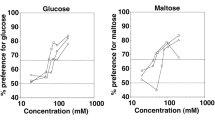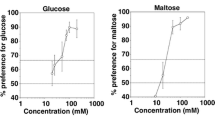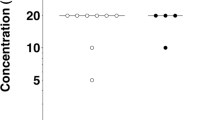Abstract
The taste responsiveness of six squirrel monkeys, five pigtail macaques, four olive baboons, and four spider monkeys to polycose, a starch-derived polysaccharide, was assessed in two-bottle preference tests of brief duration (2 min). In experiment 1, the monkeys were given the choice between tap water and defined concentrations of polycose dissolved in tap water. In experiment 2, the animals were given the choice between polycose and sucrose, fructose, glucose, lactose, and maltose presented in equimolar concentrations of 100 and 200 mM, respectively. The animals were found to prefer concentrations of polycose as low as 10 mM (pigtail macaques), 30 mM (olive baboons and spider monkeys), and 60 mM (squirrel monkeys) over tap water. Relative taste preferences were stable across the concentrations tested and indicate an order of relative effectiveness (sucrose > polycose ≥ maltose) in squirrel monkeys, spider monkeys, and olive baboons that is similar to the order of relative sweetness in humans. Pigtail macaques, however, displayed an order of relative effectiveness (maltose > polycose ≥ sucrose) that differs markedly from that found in the other primate species tested and is similar to relative taste preferences found in rodents such as rats. Both the high sensitivity of the pigtail macaques to polycose and their vivid predilection for this polysaccharide and its disaccharide constituent maltose suggest that Macaca nemestrina, unlike other primates, but like rodents, may have specialized taste receptors for starch.
Similar content being viewed by others
REFERENCES
ASTM, 1973. Compilation of odor and taste threshold values data. Data Series DS 48. American Society for Testing and Materials, Philadelphia, Pennsylvania.
BEAUCHAMP, G. K., MALLER, O., and ROGERS, J. G. 1977. Flavor preferences in cats (Felis catus and Panthera sp.). J. Comp. Physiol. Psychol. 91:1118-1127.
CALDECOTT, J. O. 1986. An Ecological and Behavioural Study of the Pig-Tailed Macaque. Contributions to Primatology, Vol. 21. Karger, Basel.
CHAPMAN, C. A. 1987. Flexibility in the diets of three species of Costa Rican primates. Folia Primatol. 49:90-105.
CLUTTON-BROCK, T. H. and HARVEY, P. H. 1977. Species differences in feeding and ranging behaviour in primates, pp. 557-584, in T. H. Clutton-Brock (ed.). Primate Ecology. Academic Press, New York.
FEIGIN, M. B., SCLAFANI, A., and SUNDAY, S. R. 1987. Species differences in polysaccharide and sugar taste preferences. Neurosci. Biobehav. Rev. 11:231-240.
FORMAKER, B. K., Kearns, C. E., and FRANK, M. E. 1998. The taste of polycose in hamsters. Chem. Senses 23:675-682.
GIZA, B. K., SCOTT, T. R., SCLAFANI, A., and ANTONUCCI, R. F. 1991. Polysaccharides as taste stimuli: Their effect in the nucleus tractus solitarius of the rat. Brain Res. 555:1-9.
GLASER, D. 1993. The effects of sweeteners in primates, pp. 353-363, in M. Mathlouti, J. A. Kanters, and G. G. Birch (eds.). Sweet-Taste Chemoreception. Elsevier, London.
GLASER, D. 1986. Geschmacksforschung bei Primaten. Vjschr. Naturforsch. Ges. Zurich 131:92-110.
HETTINGER, T. P., FRANK, M. E., and MYERS, W. E. 1996. Are the tastes of polycose and monosodium glutamate unique? Chem. Senses 21:341-347.
HIZUKURI, S. 1996. Starch: Analytical aspects, pp. 347-429, in A. C. Eliasson (ed.). Carbohydrates in Food. Marcel Dekker, New York.
KARE, M. 1971. Comparative study of taste, pp. 278-292, in L. M. Beidler (ed.). Handbook of Sensory Physiology, Vol. IV, Part 2. Springer, Berlin.
LASKA, M. 1994. Taste difference thresholds for sucrose in squirrel monkeys (Saimiri sciureus). Folia Primatol. 63:144-148.
LASKA, M. 1996. Taste preference thresholds for food-associated sugars in the squirrel monkey, Saimiri sciureus. Primates 37:93-97.
LASKA, M. 1997. Taste preferences for five food-associated sugars in the squirrel monkey (Saimiri sciureus). J. Chem. Ecol. 23:659-672.
LASKA, M. 1999. Taste responsiveness to food-associated acids in the squirrel monkey (Saimiri sciureus). J. Chem. Ecol. 25:1623-1632.
LASKA, M. 2000. Gustatory responsiveness to food-associated sugars and acids in pigtail macaques Macaca nemestrina. Physiol. Behav. 70:495-504.
Laska, M., CARRERA SANCHEZ, E., RODRIGUEZ RIVERA, J. A., and RODRIGUEZ LUNA, E. 1996. Gustatory thresholds for food-associated sugars in the spider monkey (Ateles geoffroyi). Am. J. Primatol. 39:189-193.
LASKA, M., CARRERA SANCHEZ, E., and RODRIGUEZ LUNA, E. 1998. Relative taste preferences for food-associated sugars in the spider monkey (Ateles geoffroyi). Primates 39:91-96.
LASKA, M., SCHEUBER, H.-P., CARRERA SANCHEZ, E., and RODRIGUEZ LUNA, E. 1999a. Taste difference thresholds for sucrose in two species of nonhuman primates. Am. J. Primatol. 48:153-160.
LASKA, M., SCHüLL, E., and SCHEUBER, H.-P. 1999b. Taste preference thresholds for food-associated sugars in baboons, Papio hamadryas anubis. Int. J. Primatol. 20:25-34.
LASKA, M., HERNANDEZ SALAZAR, L. T., RODRIGUEZ LUNA, E., and HUDSON, R. 2000. Gustatory responsiveness to food-associated acids in the spider monkey (Ateles geoffroyi). Primates 41:175-183.
NISSENBAUM, J. W. and SCLAFANI, A. 1987. Qualitative differences in polysaccharide and sugar tastes in the rat: A two-carbohydrate taste model. Neurosci. Biobehav. Rev. 11:187-196.
PFAFFMANN, C. 1977. Biological and behavioral substrates of the sweet tooth, pp. 3-24, in J. M. Weiffenbach (ed.). Taste and Development. The Genesis of Sweet Preference. US Government Printing Office, Washington, DC.
PLATA-SALAMAN, C. R., SCOTT, T. R., and SMITH-SWINTOSKY, V. L. 1993. Gustatory neural coding in the monkey cortex: The quality of sweetness. J. Neurophysiol. 69:482-493.
REHNBERG, B. G., MACKINNON, B. I., HETTINGER, T. P., and FRANK, M. E. 1996. Analysis of polysaccharide taste in hamsters: Behavioral and neural studies. Physiol. Behav. 59:505-516.
RICHTER, C. P. and CAMPBELL, K. H. 1940. Taste thresholds and taste preferences of rats for five common sugars. J. Nutr. 20:31-46.
ROSS, C. 1992. Basal metabolic rate, body weight and and diet in primates: An evaluation of the evidence. Folia Primatol. 58:7-23.
SAKO, N., SHIMURA, T., KOMURE, M., MOCHIZUKI, R., MATSUO, R., and YAMAMOTO, T. 1994. Differences in taste responses to polycose and common sugars in the rat as revealed by behavioral and electrophysiologcal studies. Physiol. Behav. 56:741-745.
SCLAFANI, A. 1991. Starch and sugar tastes in rodents: An update. Brain Res. Bull. 27:383-386.
SCLAFANI, A. and CLYNE, A. E. 1987. Hedonic response of rats to polysaccharide and sugar solutions. Neurosci. Biobehav. Rev. 11:173-180.
SCLAFANI, A. and MANN, S. 1987. Carbohydrate taste preferences in rats: Glucose, sucrose, maltose, fructose and polycose compared. Physiol. Behav. 40:563-568.
SCLAFANI, A. and NISSENBAUM, J. W. 1987. Taste preference thresholds for polycose, maltose, and sucrose in rats. Neurosci. Biobehav. Rev. 11:181-185.
SIEGEL, S. and CASTELLAN, N. J. 1988. Nonparametric Statistics for the Behavioral Sciences. McGraw-Hill, New York.
SPECTOR, A. C. 2000. Linking gustatory neurobiology to behavior in vertebrates. Neurosci. Biobehav. Rev. 24:391-416.
SUNDERLAND, G. and SCLAFANI, A. 1988. Taste preferences of squirrel monkeys and bonnet macaques for polycose, maltose and sucrose. Physiol. Behav. 43:685-690.
Author information
Authors and Affiliations
Rights and permissions
About this article
Cite this article
Laska, M., Kohlmann, S., Scheuber, HP. et al. Gustatory Responsiveness to Polycose in Four Species of Nonhuman Primates. J Chem Ecol 27, 1997–2011 (2001). https://doi.org/10.1023/A:1012286719241
Issue Date:
DOI: https://doi.org/10.1023/A:1012286719241




